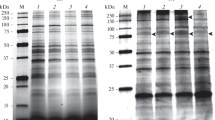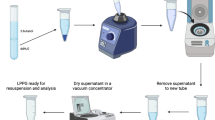Abstract
The distribution of 12 acid hydrolase and two polysaccharide depolymerase enzymes in the rumen entodiniomorphid ciliatePolyplastron multivesiculatum, isolated from the ovine rumen 2 h after feeding, was examined by differential and density-gradient centrifugation. Approximately 60%–70% of the recovered activity was sedimentable in fractions prepared by centrifugation at 103 g for 10 min (F1) and 104 g for 10 min (F2) with 25%–35% of the acid hydrolases and 15%–20% of acid phosphatase and the polysaccharidases remaining nonsedimentable (in fraction F5) after centrifugation at 105 g for 60 min. Approximately 60% of the sedimentable activity was located in fraction F1. Latency of the hydrolase activity was demonstrated. After isopycnic centrifugation in sucrose density gradients, the hydrolytic enzymes cosedimented in acid phosphatase-containing, membrane-bound, pleomorphic lysosomelike vesicles 0.1–1.0 μm in size, with a mean equilibrium density of 1.17 (1.15–1.19) g/ml.
Similar content being viewed by others
Literature Cited
Abou Akkada AR, Eadie JM, Howard BH (1963) The biochemistry of rumen protozoa. 7. The carbohydrases ofPolyplastron multivesiculatum (Dogiel & Fedorowa). Biochem J 89:268–272
Coleman GS (1983) The cellulolytic activity of thirteen species of rumen entodiniomorphid protozoa. J Protozool 30:36A
Coleman GS, Hall FJ (1978) Digestion ofEpidinium ecaudatum caudatum by the rumen ciliatePolyplastron multivesiculatum as shown by studies in the electron microscope. Soc Gen Microbiol Q 6:29–30
Coleman GS, Laurie JI (1977) The metabolism of starch, glucose, amino acids, purines, pyrimidines and bacteria by the rumen ciliatePolyplastron multivesiculatum. J Gen Microbiol 98:29–37
Coleman GS, Sandford DC, Beahon S (1980) The degradation of polygalacturonic acid by rumen ciliate protozoa. J Gen Microbiol 120:295–300
De Duve C, Wattiaux R (1966) Functions of lysosomes. Annu Rev Physiol 28:435–492
Delfosse J (1977) Ultrastructure de l'endoplasme des Ophryoscolescides. La Cellule 72:77–90
Jouany JP, Senaud J (1979) Role of rumen protozoa in the digestion of food cellulosic materials. Ann Rech Vet 10:261–263
Jouany JP, Senaud J (1982) Influence des cilies sur la digestion de different glucides chez le mouton. 1. Utilisation des glucides parietaux (cellulose et hemicellulose) et de l'amidon. Reprod Nutr Dev 22:735–752
Lindmark DG, Muller M (1974) Biochemical cytology of trichomonad flagellates. II. Subcellular distribution of oxidoreductases and hydrolases in Monocercomonas sp. J Protozool 21:374–378
Lloyd D, Brightwell R, Venables SE, Roach GI, Turner G (1971) Subcellular fractionation ofTetrahymena pyriformis ST by zonal centrifugation: changes in activities and distribution of enzymes during the growth cycle and on starvation. J Gen Microbiol 65:209–223
Lowry OH, Rosebrough NH, Farr AL, Randall RJ (1951) Protein measurement with the Folin phenol reagent. J Biol Chem 193:265–275
Morgan NA, Howell L, Cartledge TG, Lloyd D (1973) The acid hydrolase-containing organelles of eukaryotic microorganisms. In: Reid E (ed) Methodological developments in biochemistry, vol 3: London: Longman, pp 219–232
Morrison IM (1974) Changes in the hemicellulosic polysaccharide of rye-grass with increasing maturity. Carbohydr Res 36:45–51
Muller M (1971) Lysosomes inTetrahymena pyriformis. II. Intracellular distribution of several acid hydrolases. Acta Biol Acad Sci Hung 22:179–186
Muller M (1973) Biochemical cytology of Trichomonad flagellates. 1. Subcellular localization of acid hydrolases, dehydrogenases and catalase inTritrichomonas foetus. J Cell Biol 57:453–474
Muller M, Baudhuin P, De Duve C (1966) Lysosomes inTetrahymena pyriformis. 1. Some properties and lysosomal localization of acid hydrolases. J Cell Physiol 68:165–176
Poole RK, Nicholl WG, Turner G, Roach GI, Lloyd D (1971) Sedimentation characteristics of mitochondria, peroxisomes, and lysosomes from the ciliate protozoonTetrahymena pyriformis strain ST after chloramphenicol-inhibited growth. J Gen Microbiol 67:161–173
Stern MD, Hoover WH, Leonard JB (1977) Ultrastructure of rumen holotrichs by electron microscopy. J Dairy Sci 60:911–918
Stern MD, Hoover WH, Summers RG, Rittenburg JH (1977) Ultrastructure of rumen entodiniomorphs by electron microscopy. J Dairy Sci 60:902–910
Thines-Sempoux D, Delfosse-Debusscher J, Lefebvre V, Absil JP, Hellings P (1980) Aspects of “bacteria-ciliates” symbiosis in the rumen: postulated role of the bacteria in the digestive system of the ciliate. In: Schwemmler W, Schenk HEA (eds) Entocytobiology: endosymbiosis and cell biology, a synthesis of recent research. Proceedings of the international colloquium on endosymbiosis and cell research. Berlin: Walter de Gruyter, pp 371–379
Williams AG, Coleman GS (1985) Hemicellulose degrading enzymes in rumen ciliate protozoa. Curr Microbiol (in press)
Williams AG, Harfoot CG (1976) Factors affecting the uptake and metabolism of soluble carbohydrates by the rumen ciliateDasytricha ruminantium isolated from ovine rumen contents by filtration. J Gen Microbiol 96:125–136
Williams AG, Yarlett N (1982) An improved technique for the isolation of holotrich protozoa from rumen contents by differential filtration with defined aperture textiles. J Appl Bacteriol 52:267–270
Williams AG, Withers SE, Coleman GS (1984) Glycoside hydrolases of rumen bacteria and protozoa. Curr Microbiol 10:287–294
Yarlett NR (1982) The biochemistry and physiology of some anaerobic protozoa. PhD thesis, University of Wales
Yarlett N, Hann AC, Lloyd D, Williams AG (1981) Hydrogenosomes in the rumen protozoonDasytricha ruminatium Schuberg. Biochem J 200:365–372
Yarlett N, Hann AC, Lloyd D, Williams AG (1983) Hydrogenosomes in a mixed isolate ofIsotricha prostoma andIsotricha intestinalis from ovine rumen contents. Comp Biochem Physiol 74B:357–364
Yarlett N, Coleman GS, Williams AG, Lloyd D (1984) Hydrogenosomes in known species of rumen entodiniomorphid protozoa. FEMS Microbiol Lett 21:15–19
Author information
Authors and Affiliations
Rights and permissions
About this article
Cite this article
Williams, A.G., Ellis, A.B. Subcellular distribution of glycoside hydrolase and polysaccharide depolymerase enzymes in the rumen entodiniomorphid ciliatePolyplastron multivesiculatum . Current Microbiology 12, 175–181 (1985). https://doi.org/10.1007/BF01567672
Issue Date:
DOI: https://doi.org/10.1007/BF01567672




